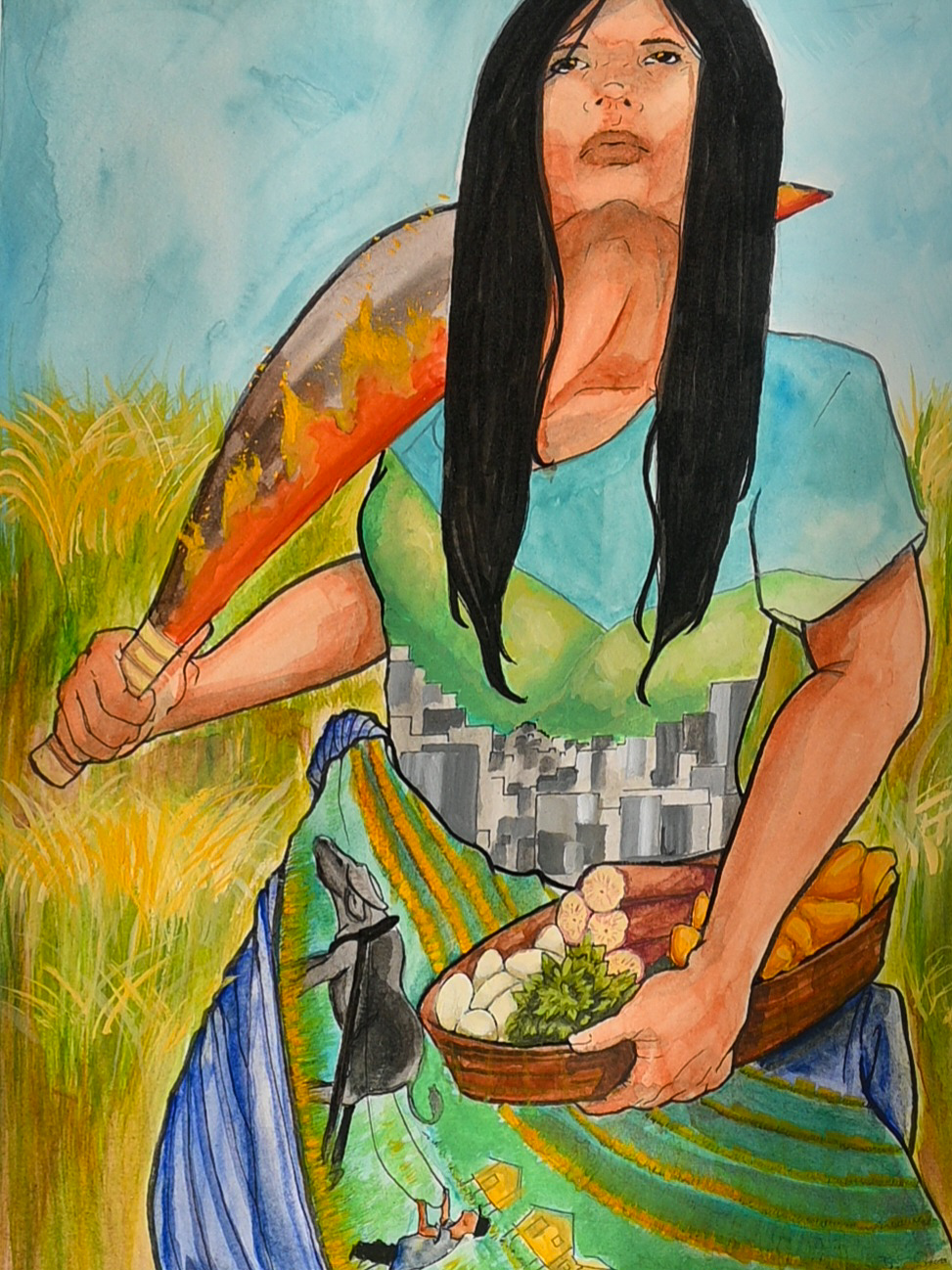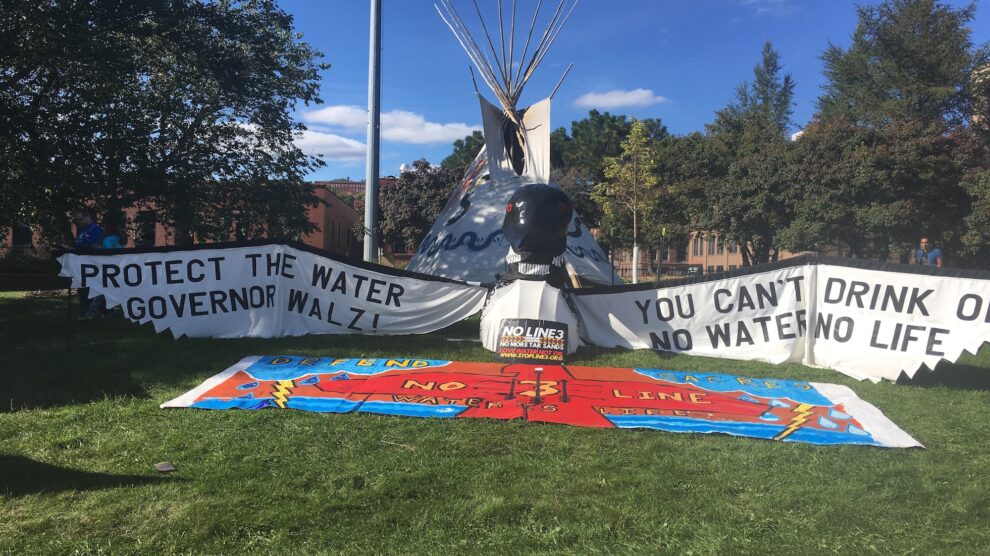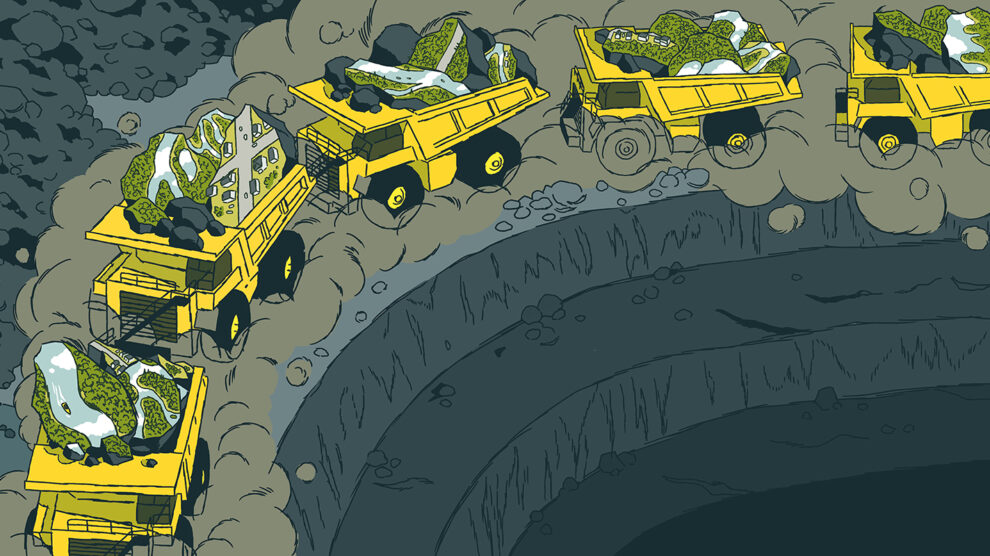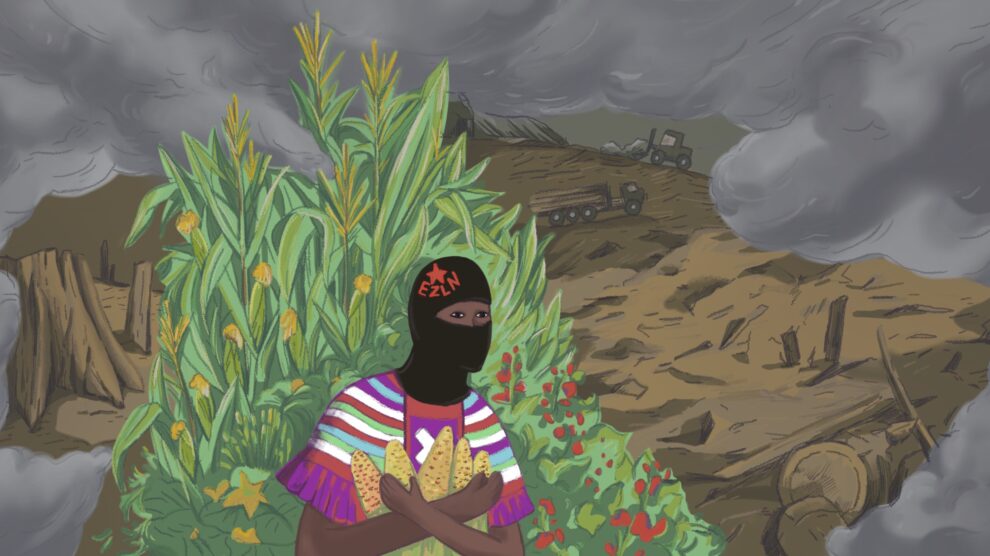Making Space and Knowing Nature Through Anti-Imperialist Struggle in the Philippines
By Jon Bonifacio

Modern science, as we know it today, has not only produced new ways of knowing the natural world, but has also been built on the systemic erasure of traditional and Indigenous epistemologies. A wealth of examples around the world document the rise and subsequent domination of capitalist scientific methods of understanding natural phenomena, a process of privileging that is accompanied by the denigration and vilification of other knowledge systems on top of other forms of violence. In the context of collapsing biodiversity and climate change, movements continue to reclaim local and Indigenous food production practices, worldviews, and so much more as potential solutions for the crises we face.
Specific forms of scientific practice have been central to capitalist ideologies and modernity projects. Aside from the regular deployment of scientific concepts and technologies guiding capitalist extraction and accumulation, some have argued that much of Western scientific thought is, from the onset, rooted in an understanding of the world that makes capitalist accumulation possible. For example, biologists Levins and Lewontin have challenged the Cartesian reductionist paradigm and its relation to capital, arguing that the obsession of the molecular biologist to the gene or that of the physicist to the atom is not dissimilar to the pervasive individualist philosophy of capitalism: understanding the natural world, or the economy, as simply a sum of its parts.1 Modern science and its myriad disciplines aim to decipher the natural world, making it “legible” for accumulation.2 Through practices such as remote sensing and mapping of extractable resources, this approach to knowing separates part from whole, instead of understanding relationships between distinguishable phenomena. It is easy to draw parallels between global capitalism’s assimilation or replacement of other modes of production and Western science’s assimilation or replacement of other systems of knowledge.
This process of epistemological violence does not solely take place in the realm of ideas. Over centuries and around the world, this process has been intimately bundled with instances of dispossession, primitive accumulation, and colonization that have changed the terms on which peoples are able to engage with and know nature. I approach this process through a materialist lens, which must consider the question of land—in other words, our access to nature, and how this access informs both traditional and modern knowledge systems. Framed in this manner, it becomes crucial to understand how we materially interact with nature in space and time, and how these interactions flourish through or are flattened by one historical process or another.
Stories from the Philippines capture many aspects of this phenomenon of epistemic erasure, which have wreaked both physical violence as well as psychosocial trauma and global harm. In the cases that follow from the Philippines, I highlight the ongoing anti-colonial, anti-imperialist struggle from the Global South in reclaiming and generating spaces and opportunities for knowledge production as a process intimately tied to the land.
Kaingin and Colonial Policies of Vilification
The history of the longstanding practice of kaingin (English: swidden or slash-and-burn agriculture) shows a clear case of epistemic violence linked to land struggles. Practiced by some Indigenous communities up to the present day, kaingin is a part of a cultural practice that, in addition to its use in producing food for communities, includes ritual and mythological features expressing alternate ways of appreciating nature. For example, the Batak peoples of Palawan assign human personalities and archetypes to nonhuman elements of nature who guide their forest clearing activities.3 However, as we will see, colonial policies would lead to massive changes in how kaingin is understood and perceived in the Philippines, which in turn, is bound to the evolution of conceptions of Indigeneity over time.
Indigenous peoples in the Philippines have formed their unique identities in part through geographical divides that were magnified or even produced by colonial occupation. Prior to the arrival of the Spanish colonizers, a plurality of distinct societies already existed in the Philippine archipelago, enmeshed in a complex web of relations with other societies across Southeast Asia and beyond. Spain’s colonial rule over the Philippines, beginning formally in 1565, came with the explicit attempt to homogenize these island societies within their reach in line with the whims of the Spanish crown.
“Within their reach” would be the operative phrase in the last sentence. The Regalian Doctrine, by unilaterally declaring that all lands of the Philippine archipelago now belonged to the Spanish crown, sought to subjugate all the new colonial subjects through violent dispossession as well as altering existing land management systems. These strategies drastically altered existing relations of native peoples with the lands and waters of the archipelago, and encompassed the physical displacement of communities to the subjugation of producers under new tenant arrangements with Spanish colonial motivations.
However, the process was far from a complete success. With the ability of locals to evade Hispanicization, in many cases simply by retreating into upland areas, the colonial administration began leaning on what would end up becoming racist discourse. Those who would not submit to Spanish rule—and relatedly, submit to the colonial land policy—were termed tribus salvajes or savage tribes (among other derogatory terms). Meanwhile, populations that remained in the lowlands and within Spanish influence became the “civilized” indio, a racial category of its own.4
From this, we can begin to understand how kaingin came to be vilified as a practice. As a practice associated with these “savage tribes”, kaingin conflicted with the sedentary farming enforced by the Spanish colonial state. With the establishment of the Inspeccion General de Montes (English: Forestry Bureau) in 1863, kaingin—associated with its Indigenous practitioners living in forested upland areas—was stigmatized as a scourge to the highly valuable timber resources of the Philippines. By 1874, the practice was officially banned by the Spanish colonial government.
The vilification of kaingin continued into the colonial period under the United States, which began in 1898. Surveying the vast treasure trove of forest resources up for grabs in the Philippines, Yankee imperialism was particularly concerned with the use of fire in swidden agriculture. Associated with both upland Indigenous peoples and dispossessed lowland peasantry, kaingin posed a threat to possible economic gains. In 1910, ecologist Barrington Moore lamented the loss of up to $100,000 worth of timber “destroyed by Caingins” in their use of kaingin in a locality, in the island group of Mindanao, to manage the land. The Philippine Bill of 1902 also reproduced the colonial land policy of the Spanish, further entrenching the divide between land-holders—whose lifestyle around sedentary agriculture had already taken root—and sustained the exclusion of traditional and Indigenous peoples.5
As the United States also established the first forestry school in the country in 1910, it should come as no surprise that foresters and other experts trained during, and even well after, the formal Yankee colonization period still adopted colonial notions and definitions of “proper” agriculture and forest management.
Bakwit and a Radical Pedagogy by the Lumad
In this context of continuing colonialism in the Philippines, Indigenous communities have sustained their resistance to imperialism and its local manifestations. The alternative education systems established by the Lumad exemplify how knowledge systems are tied to land struggles. I will now explore the Lumad schools and their bakwit (English: evacuate, specifically referring to forced evacuation) iterations.
The term “Lumad”—meaning “born from the earth”—collectively refers to several Indigenous peoples living in remote areas of Mindanao. Successive Lumad leaders and communities have led campaigns against extractive operations in their ancestral lands.6 State forces, including military-backed armed groups, have countered with a ruthless offensive against Lumad communities, resulting in horrendous massacres, widespread displacement, and other human rights violations including child rape.
The Lumad schools were set up to address the need for education in remote communities, in situations where Lumad children used to walk several kilometers just to attend class. Instead of simply replicating mainstream educational curricula, these schools sought to conserve Indigenous ways of knowing by emphasizing topics relevant to the community’s needs. For example, the Alternative Learning Center for Agricultural and Livelihood Development (ALCADEV) put sustainable agriculture at the core of its curriculum. This was done to acknowledge the centrality of agriculture to Lumad communities. Even other subjects like mathematics, history, and health were taught in relation to agriculture and the land. Another school, the Community Technical College of Southern Mindanao (CTCSM), combined Indigenous and organic farming practices in their agroecology curriculum.7
Instead of simply replicating mainstream educational curricula, these schools sought to conserve Indigenous ways of knowing by emphasizing topics relevant to the community’s needs.
Rampant militarization, threats from government agencies, and other state-sanctioned attacks forced many of these Lumad schools to close. By labeling the Lumad schools as “communist recruitment centers” for integrating opposition to mining and logging projects into their curriculum, state forces clamp down on resistance and target Lumad educational systems that upheld Indigenous ways of life, including their ways of knowing.
However, even in the context of displacement and forced evacuation, the Lumad education centers persisted through bakwit school initiatives. Following forced evacuation due to militarization, the Lumad school movement took refuge in temporary sanctuaries such as universities and religious institutions. In the Lumad bakwit school in the University of the Philippines Diliman, hundreds of kilometers away from their ancestral lands, components of the Lumad school curricula, including Indigenous customs, were sustained despite the lack of resources and the difficulty of replicating the Lumad school in an urban setting.8 In many ways, the bakwit school demonstrates an insistence on self-determination based on a kind of radical pedagogy rooted in continued resistance to large-scale extractive projects in Mindanao and beyond.
The example of the Lumad school movement clearly shows this marriage between the struggle for land and education as a mode of indigenous communal preservation. The fight to recuperate and preserve Indigenous knowledge systems is intimately coupled with resistance against the dispossession and displacement associated with capitalist expansion and extractive industries.
Bungkalan in Lupang Ramos
Indigenous and peasant movements in the Philippines have historically shared many common elements in their struggle for land and rejection of imperialism. Land issues such as depressed sale prices for producers, stunted agricultural production rates, and pervasive landlessness have been recognized by groups like Kilusang Magbubukid ng Pilipinas (English: Peasant Movement of the Philippines) or KMP as symptomatic of the neoliberal world order. Through the process of bungkalan—a collective assertion of rights to land by tilling the soil—peasant groups have been able to take back land from elite control, and consequently make space for other ways of knowing nature.
Through the process of bungkalan—a collective assertion of rights to land by tilling the soil—peasant groups have been able to take back land from elite control, and consequently make space for other ways of knowing nature.
Lupang Ramos, located in the province of Cavite, is a product of this struggle. Located just over an hour south of Manila, Lupang Ramos spans 372 hectares of verdant farmland in the middle of densely urbanized area of Dasmariñas. This anomaly, in the heart of the city, was made possible only through the organized action of Lupang Ramos farmers, under the collective leadership of Katipunan ng mga Lehitimong Magsasaka at Mamamayan sa Lupang Ramos (English: Organization of the Legitimate Farmers and Citizens in Lupang Ramos), or KASAMA-LR, a group affiliated with KMP.
The struggle for Lupang Ramos spans over thirty years of resistance, with a series of land occupations in the 1980s, following the downfall of the dictator Marcos Sr. Through bungkalan, Lupang Ramos residents have progressively reclaimed the entire 372 hectares despite harassment from armed private goons, the military, and the police. Through this process, farmers cultivated their collective power and leveraged it to wrest control away from the landed elite, as well as generated internal solidarity to overcome challenges and attacks that continue to this day.9
Hence, in Lupang Ramos, farmers own the land that they till. What was once an agricultural expanse sown almost entirely in sugarcane monoculture, is now devoted to a wider variety of rice, corn, eggplants, mung beans, fruits, and vegetables directly benefiting residents. Additionally, testimonies from women leaders of KASAMA-LR reveal a more relational approach to the land. Instead of it being transactional or exploitative, these women recounted experiences and practices that are “deeply connected” to a person’s entire being, picturing the land as the “embrace of every mother”, or the land as life itself.10 These are very different ways of appreciating nature, emerging through the active, collective rejection of elite control.
Undergirded by the organizational strength of KASAMA-LR, Lupang Ramos farmers are now able to dictate the terms on which they engage with nature, and now have the space to explore and develop traditional practices for the benefit of their community. For example, in the first year of the COVID-19 pandemic, Lupang Ramos residents established what they called a “COVID garden” at the height of the nationwide lockdown. Here, traditional medicinal plants like lagundi (used to treat coughs and colds) were sown to treat colds, fevers, and other illnesses as a community response to weak health systems and gaps in services.11 In this concrete way, herbal remedies drawing from traditional knowledge are preserved, disseminated, and even developed amid the disruptions of a pandemic disaster.
Lupang Ramos residents also developed local agroecological practices for more sustainable food production. With local scientist groups, they have worked on reclaiming knowledge on composting organic waste, harnessing native microorganisms, and using traditional rice and vegetable crop varieties in their farming.12 This engagement, promotion, and local adaptation of traditional cultivation methods—a process of knowing nature—would be unimaginable under the rule of a despotic landlord or on a cash-crop plantation.
Traditional medicinal plants like lagundi (used to treat coughs and colds) were sown to treat colds, fevers, and other illnesses as a community response to weak health systems and gaps in services.
Conclusion
From these examples, two observations can be made. First, our collective experience of nature, captured in part by our ways of knowing, has largely been flattened by modern science under colonialism and imperialism. Traditional and Indigenous ways of understanding nature have historically been disregarded in favor of modern scientific theory. By revisiting history and understanding how our knowledge systems have been shaped by political decisions, we are presented with an opportunity to also reexamine our relationship with nature and see what we may learn from the various ways of knowing of the different peoples of the world.
Second, the preservation and development of ways of knowing nature is tightly bound to the struggle for land. In the same way colonial powers were able to impose certain knowledge systems through changing peoples’ relations with the land, so are grassroots movements able to recuperate traditional practices and knowledge through self-determination and land-to-the-tiller campaigns. In the latter case, these movements can lead to the proliferation of more ecologically-attentive practices, as well as increased community resiliency in the face of disasters such as the COVID-19 pandemic.
These stories from the Philippines are only a few among many more across the world. It is through analyzing and appreciating these diverse examples that we can draw important lessons for our work as activists and revolutionaries. In a world in dire need of alternative ways of knowing and being, it is both comforting and inspiring to know that these are being forged here and now in the laboratory of anti-colonial, anti-imperialist struggle.
Meet the contributor:
Jon Angelo Bonifacio: Jon is a climate and environmental activist from the Philippines, and the current National Coordinator of Kalikasan People’s Network for the Environment, a nationwide environmental campaign center of grassroots and sectoral organizations. They are also a rap and visual artist. Twitter: @jamzbonifacio / IG: @bnfcio
Notes
- Richard Levins and Richard Lewontin, The Dialectical Biologist (Cambridge: Harvard University Press, 1985), 1–3.
- Jason Moore, Capitalism in the Web of Life (London: Verso Books, 2015), 208–211.
- Wolfram Dressler, Will Smith, and Marvin Montefrio, “Ungovernable? The Vital Natures of Swidden Assemblages in an Upland Frontier,” Journal of Rural Studies 61, (2018): 343–354.
- Will Smith and Wolfram Dressler, “Forged in flames: Indigeneity, Forest Fire and Geographies of Blame in the Philippines,” Postcolonial Studies 23, no. 4 (2020): 5–7, https://doi.org/10.1080/13688790.2020.1745620.
- Smith and Dressler, “Forged in Flames,” 9–10; Richard Tucker, Insatiable Appetite: The United States and the Ecological Degradation of the Tropical World (London: University of California Press, 2000), 378.
- lod Marlan Krister Yambao et al., “‘I am the Land and I am their Witness’: Placemaking amid Displacement among Lumads in the Philippines,” Critical Asian Studies 54, no. 2 (2022): 259–281.
- Jose Monfred Sy, “Till the Land, Defend the Land: Reflections on the Critical Place-based Pedagogy of the Alternative Learning Center for Agricultural and Livelihood Development, Surigao del Sur,” AlterNative 18, no. 3 (2022): 402–411.
- Yambao et al., “‘I am the Land,” 259–281; Sy, “Till the Land,” 402–411.
- Katipunan ng mga Lehitimong Magsasaka at Mamamayan sa Lupang Ramos (KASAMA-LR), Lupang Ramos: Isang Kasaysayan [Lupang Ramos: A history] (Philippines: Gantala Press, 2019), 4–13.
- KASAMA-LR, “Lupang Ramos,” 17–57.
- Miriam Villanueva (secretary-general of KASAMA-LR), in discussion with the author, December 2021.
- Janess Ann Ellao and Lia Mai Torres, “‘Bungkalan’ in Lupang Ramos: The Collective Struggle for Land and Climate-resilient and Community-led Food Production,” Bulatlat, October 21, 2021, https://www.bulatlat.com/2021/10/21/bungkalan-in-lupang-ramos-the-collective-struggle-for-land-and-climate-resilient-and-community-led-food-production.





